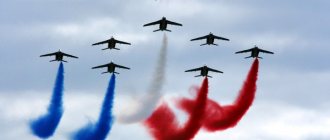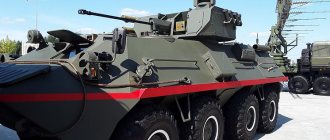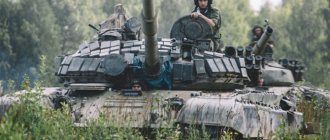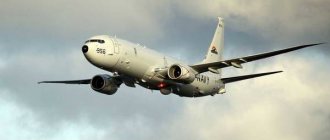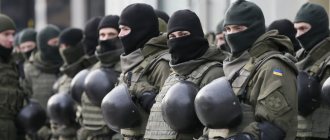Of course, it is no secret that scientific and technological revolution begins, first of all, with the military-industrial complex. And in the budgets of developed countries, financing the army is by no means the last page. In this regard, a completely natural question arises: will there be anything new in Russia’s armament in 2022?
Of course, ordinary people grumble about the high costs of modernizing and supporting military forces. But there is an ancient saying in favor of the development of the army: if you don’t want to feed the army of your country, then, of course, you will have to feed someone else’s. In our time, when there is a hidden confrontation between the strongest countries over mineral resources that are disappearing at incredible speed, the armies of the main powers on the world stage must be at the proper height.
RPK-16 light machine gun
This is an initiative development of the Kalashnikov concern, a replacement for the Kalashnikov RPK-74 light machine gun.
It will be used both in conventional troops and in special forces. The designers incorporated into the light machine gun all the developments gained during the creation of the AK-12 assault rifle model. But there is also an innovation - an aiming system. Now it is located on the receiver cover. The stock is folding and telescopic. Its range of adjustments allows you to customize the machine gun for a shooter with any biometrics. The PMS tactical silencer significantly reduces the sound level of a shot. This allows you to protect your hearing aid and reduces the flash of muzzle gases.
Hero (2016)
Kinopoisk: 5.5 IMDb: 5.0 +12 A representative of a noble name and a brave military man meet each other at the beginning of the 20th century. However, the love that arises is not destined to last long. War breaks out and the lovers are separated. He goes to the front, she goes as a nurse to the hospital. For several decades the world plunges into chaos. One war follows another. But the line of love does not disappear and, having survived several generations, it finds a way to be reborn after 100 years.
Note:
War films about Chechnya and Afghanistan.
MiG-35 fighter
The new MiG-35 fighter is a modernized version of the Soviet MiG-29.
Although it looks similar to its predecessor, in terms of technical characteristics it is a completely new aircraft. Firstly, the maximum take-off weight increased by 30 percent, reaching 23.5 tons. Secondly, the MiG-35 has high combat survivability; it is difficult to see and, therefore, shoot down. The plane can rise to a height of up to 17 kilometers. This allows him to shoot down an air target at a 10-kilometer altitude. The fighter is able to accelerate to 2300 kilometers per hour. It will take 4.5 tons of weapons on board and fly with them up to 5.5 thousand kilometers. The pilot can find and track enemy aircraft at a distance of up to 120 kilometers thanks to the installed on-board radar system. In addition, another onboard unit helps extract oxygen from the air. The MiG-35 carries air-to-air and air-to-surface missiles, is armed with guided bombs and unguided missile weapons. To engage ground targets, the fighter has a GSh-301 automatic cannon with 150 rounds of ammunition. NATO has already dubbed the new multi-role fighter MiG-35 Fuicrum-F, which means “Fulcrum”.
The latest weapons of Russia: developments, samples and their characteristics
The situation in the modern world is such that the Russian Federation, in order to maintain its sovereignty and play key roles in the international arena, is forced to strengthen its combat capability. What is strengthening combat capability? This is, first of all, strengthening the Russian army with new weapons - classified types of weapons, and those that Russia sells to other countries.
This article will discuss the latest weapons developments in Russia. Some of these weapons are already in use by our troops, other new models are at the development and testing stage, and should enter service with the Russian army in 2018-2019.
Here it should be said again that Russia is currently developing and testing many types of new generation weapons, and testing new weapons in Russia is a secret matter. For obvious reasons, nothing can be said about such weapons yet. In addition, it is simply impossible to talk about all new developments in a separate article, so we will only talk about some of the most high-profile examples of modern Russian weapons.
Generally speaking, according to prominent arms experts and politicians, in the coming years the Russian armed forces should receive:
More than 600 aircraft of different types: fighters, long-range aircraft, strategic bombers, etc.;
More than 1000 of the latest helicopters;
More than 300 new super-air defense systems;
New generation ballistic missiles with nuclear warheads;
New nuclear weapons;
New high-precision weapons (bombs, missiles, etc.), as well as the latest guidance systems for such weapons, designed for high-precision shooting;
New weapons to destroy tanks and other ground vehicles;
The latest models of small arms and military equipment;
Various new generation military equipment, as well as other products from domestic arms manufacturers.
In addition, the Russian Armed Forces should soon receive automated command and control systems. Russia is also developing a new secret weapon. According to some information, the latest Russian small arms are currently being developed, the operation of which is supposed to be based on fundamentally new physical methods.
Soldier with a new machine gun
In addition, work continues on the creation of hypersonic missiles, which are supposed to be based not on the surface of the earth, but in the airspace. It is assumed that the speed of such missiles will be 7-8 times higher than the speed of sound. This, for obvious reasons, will be Russia's newest secret weapon.
Newest tanks
In addition, work is underway in Russia on other types of superweapons. Some of these types of Russian superweapons will be discussed below.
Russian nuclear weapons
It is known that the main shield of our country is strategic nuclear weapons. The well-known domestic models of strategic nuclear weapons “Voevoda” and “Sotka” are still serving well today. However, they are already being replaced with more advanced models (“Topol”, “Topol-M”).
However, in addition to those listed, Russia’s new secret weapons, that is, new models of strategic missiles, are now being actively and successfully developed and implemented. Here are just a few of them:
The newest strategic missile
RS-24 Yars. The rearmament of the Russian army with such missiles is, in fact, already underway. According to the Russian command, missiles of this type will replace outdated models of strategic missile weapons (the same “Topol” and “Topol-M”);
RS-26 Rubezh. This complex is designed to use an intercontinental ballistic missile with increased firing accuracy. In 2014, the complex entered service with the Russian army. It is assumed that this missile will in the future replace the Topol-M and Yars;
BZHRK Barguzin. Since this type of weapon is not yet used in the Russian army (it is under development), there is little information about it. This new Russian secret weapon is expected to be operational in 2022;
Vanguard rocket launcher. This is a fundamentally new weapon, its effectiveness compared to the same “Topol-M” can be 50 times higher. The warhead of this missile is capable of flying from 16 to 25 thousand km. The missile launcher is expected to be put into service in 2018;
Bottom missile systems. These are, in fact, missile launchers located on the seabed and, accordingly, launch missiles from the depths of the sea. One of these complexes was named “Skif”. The essence of the action of such a complex is as follows. The rocket, located on the seabed, is in constant standby mode. When the command is fired, the missile fires and hits a surface ship or some ground target. The water column serves as a kind of shaft for the rocket. The first test launch of the rocket since the White Sea was carried out back in 2013. The development of bottom missile systems continues to this day;
Mobile missile systems. Based on the name, such complexes can be moved from place to place, which is their considerable advantage compared to stationary complexes. In Russia, work is currently underway on the creation of railway and sea mobile missile systems. One of the trial sea mobile missile systems was placed in an ordinary cargo container. The test launch of a rocket from such a complex produced a considerable effect among observers and experts.
Column of rocket weapons
Let us repeat: all this is only a small part of the missile weapons put into service in 2022 or planned to enter the Russian armed forces in the near future.
Anti-tank weapons
As for anti-tank weapons, there are also unique samples that have no analogues anywhere in the world. Here are just a few of these samples:
Missile system Kornet-D. This is a very effective weapon for destroying enemy armored vehicles. Since the complex is a missile system, it follows that the destruction of enemy armored vehicles is carried out by missiles;
Hermes complex. Its first version, called "Hermes-A", was intended to be destroyed using helicopters. The complex is attached to a helicopter, and in this way fire is fired at enemy armored vehicles. Currently, work is underway to create new variants of ATGMs, which are designed to expand and diversify the use of weapons. In particular, it is known that in the near future, missiles fired from the Hermes complex should be used from the Pantsir-S1 anti-aircraft missile system;
MGK BUR. Essentially, this is a new and improved type of grenade launcher, which has a reusable launcher and one shot. That is, after each shot, the grenade launcher must be reloaded, as was the case in all previous versions of this type of weapon.
The latest anti-tank weapons
Other types of anti-tank weapons that are currently being worked on are classified, and therefore there is no need to talk about them in detail.
New small arms
When speaking of “Russia’s new weapons,” it is impossible to avoid mentioning the new small arms produced in the country. Missiles, planes and ships are, of course, wonderful, but it is small arms that are primarily capable of protecting the most valuable thing - the life of a soldier. Here are just some of the new models of Russian small arms:
Double-medium ADS machine
Double-medium ADS machine. This is a unique new Russian small arms that can fire both in the open air and under water. In addition, the machine gun is designed in such a way that it can be fired from both the left and right hands. Serial production of the assault rifle began in 2016, and it entered service with the Russian army in 2022;
SVLK-14S. This rifle is an exceptionally accurate Russian sniper weapon, which can effectively hit a target at a distance of up to 2 km. In addition, it is the most powerful small arms to date;
Lebedev pistol (PL-14). Domestic pistols are perhaps the weakest point of our small arms. The famous “Makarov” has long been outdated - both in terms of its fighting qualities and in other senses, there are also complaints about other domestic pistols. Against this background, the new domestic pistol, developed by designer Lebedev, looks very attractive. The pistol is very light and thin, it can be fired with both the right and left hand, it has little recoil, the accuracy of fire and the rate of fire are superior to existing domestic analogues. The pistol should enter service with both the army and the police. In addition, the designers also promise a sports version of the PL-14.
Lebedev pistol PL-14
Currently, several defense enterprises in the country are working on the creation of a fundamentally new small arms, in no way similar to the famous Kalashnikov assault rifle. In particular, it is already known that such a weapon will have a striking mechanism and buttstock in the stock, and such weapons are supposed to be fired with specially designed (innovative) cartridges. Such cartridges will have significantly increased accuracy and firing range, as well as destructive power. The first samples of such weapons have already entered the Russian armed forces this year. Massively new small arms will begin to enter the army and special forces in 2022.
Robots as Russia's newest weapon
It is clear that in the age of electronic technology, robots can (and must) also be weapons. Which is exactly what is happening. This year, Russia began creating special forces robots. According to the designers, such robots will be able to provide significant assistance to soldiers on the battlefield: helping snipers in choosing a target, delivering ammunition, and also performing the functions of orderlies - that is, finding the wounded, providing them with first aid and transporting them to medical facilities. Such robots are currently being tested.
Another combat robot (or rather a robotic military complex), which was given the name “Nerekhta”. It moves on tracks and is armed with a Kord machine gun. Initially, the robot was conceived as an artillery fire spotter, but the designers soon realized that for such a machine being just a spotter was not enough.
Currently, the Nerekhta robot can go on reconnaissance, quietly destroy an enemy pillbox, open fire with a machine gun, and thereby support its fighters. The robot is capable of moving up to 30 km per hour and is controlled via a remote control. Since the robot is equipped with an optical-electronic system, a thermal imager, a laser range finder and a ballistic computer, it is currently also successfully used as a guard for missile systems.
The newest combat robot "Nerekhta"
Currently, work is underway to improve the robot. Thus, this year an improved version of Nerekhta-2 was tested. Such a robot will be the fighter’s “squire,” that is, he will carry the fighter’s weapons and equipment. The robot can be controlled by voice and gestures. In addition, the robot will act in sync with the fighter it is serving. For example, if a fighter took aim and shot at a target, then the robot will also shoot at the same target with its weapon - for reliability and safety net.
Icebreaker "Ilya Muromets"
The Project 21180 diesel-electric icebreaker Ilya Muromets was launched in June 2022 at the Admiralty Shipyards in St. Petersburg. He will serve as part of the Northern Fleet. In fact, the Ilya Muromets is not just an icebreaker, it is a multifunctional auxiliary vessel of a high ice class. “Ilya Muromets” will be engaged in supplying Arctic coastal and island bases and airfields, towing ships in ice conditions and in clear water, and transporting various cargoes. As they say about “Ilya Muromets” in the Russian Navy, it contains the characteristics not of today, but of tomorrow. These are seaworthiness, maneuverability, versatility and a completely new electric principle of propulsion. The icebreaker is 85 meters long, 20 meters wide, and has a full speed of 15 knots. The new icebreaker will be able to sail for up to two months, with a cruising range of 12 thousand nautical miles, or 22,244 kilometers.
Commissioner (2017)
Kinopoisk: 5.9 Having left a small town, Galina Semenova went to Moscow to graduate from college and get a job in the police. At home, she left her little son Ilya in the care of her mother. After years of war, returning home to her hometown, she discovers that it is necessary to establish strict order here and disperse the main gang, but this gang includes her already adult son.
Note:
- The best war films about the Second World War 1941 - 1945.
- The best Russian military series of all time.
- Films about pilots in the war of 1941 - 1945 - Russian films.
Mi-28UB helicopter
The new helicopter was assembled at Rostov. It made its first flight on August 9 this year.
This is a combat training modification based on the Mi-28N attack helicopter. The main difference between a training machine and a shock machine is the presence of a double set of control system based on hydromechanics. Therefore, the helicopter can be controlled from any cockpit. In the front cockpit, instead of the systems operator, there is an instructor, and in the rear cockpit, there is a trained pilot. In this regard, the dimensions of the front cabin have been increased and the rear canopy has been expanded. They also installed new energy-absorbing seats to protect the pilot from injury during a hard landing. According to the Air Force Commander-in-Chief, Lieutenant General Viktor Bondarev, the use of the Mi-28UB training helicopter will reduce the training period for military pilots by two to three times. By 2022, the Russian Ministry of Defense will purchase from 40 to 60 such vehicles.
New nuclear strategic missiles
The basis of Russia's shield is strategic nuclear weapons. Its main representatives are the heavy liquid-propelled ICBMs Sotka and Voevoda. Their service life has already been extended three times. Today they are being replaced by the Topol and Topol-M missiles, and promising new generation nuclear weapons are and will continue to be supplied.
RS-24 Yars
RS-24 Yars is a new nuclear weapon that is produced in Votkinsk at the Votkinsk Machine-Building Plant. RS-24 missiles will gradually replace RS-20 and RS-18 ICBMs once their warranty periods have expired. The Yars complexes began to be deployed in December 2009 after they passed the test. In November 2010, General S. Karakaev, Commander-in-Chief of the Strategic Missile Forces, announced that mobile systems with monoblock Topol-M missiles would gradually be re-equipped with Yars mobile systems. In 2015, units of the Strategic Missile Forces are being actively equipped with RS-24 Yars missiles.
300w" style="margin: 0px; padding: 0px; border: 0px; vertical-align: bottom; max-width: 100%; height: auto;" width=”600″ />
RS-26 Rubezh
RS-26 Rubezh is a strategic missile system that uses an intercontinental ballistic missile with increased firing accuracy. Nuclear weapons are being developed by the Moscow Institute of Thermal Engineering. The development of the complex has been ongoing since 2006. In the period up to 2009, research was carried out by national research universities on the topic “Frontier”.
The first test launch of the RS-26 Rubezh in 2011 ended in an accident. The second and third launch took place in 2012 from the Plesetsk and Kapustin Yar test sites. During the launches, the anti-missile capabilities of the new missile were assessed. The fourth launch took place in 2013. Starting from 2014, the Rubezh complex rocket will be mass-produced at the Votkinsk Machine-Building Plant. Since 2014, the complex has been adopted by the Strategic Missile Forces. The new missile in the future will replace the Topol-M ICBM, as well as the Yars.
300w" style="margin: 0px; padding: 0px; border: 0px; vertical-align: bottom; max-width: 100%; height: auto;" width=”600″ />
ICBM "Sarmat" RS-28
The promising heavy ICBM Sarmat RS-28 is a new generation missile. It began to be designed in 2009. According to the original plan, it was supposed to be operational by the end of 2016. The purpose of creating a heavy missile was to replace the RS-20 Satan ICBM as part of the Strategic Missile Forces. The development of ICBMs is carried out in the city of Miass State Research Center named after. Makeev with the participation of NPO Mashinostroeniya. The terms of reference for the design of a new generation ICBM were approved in 2011. In September 2012, a large council was held on the new rocket, where all the developers, up to level 2-3, met. At the beginning of October, the Ministry of Defense generally approved the design of the new ICBM, but a number of comments and suggestions were indicated that the developers needed to take into account during further design.
In May 2014, Yuri Borisov, Deputy Minister of Defense, said that work on the creation of the Sarmat ICBM was going according to plan, and that the missile was capable of flying through the South and North Pole. The production of ICBMs will be carried out by a cooperation of enterprises, which was formed by the State Research Center named after V. Makeev - this will be the Krasnoyarsk Machine-Building Plant and other related enterprises. The construction of a full-scale prototype of the rocket was carried out in 2014. In 2015, a rocket test should take place, as well as a number of other tests. In February 2015, the Krasnoyarsk Machine-Building Plant produced the first structural elements of the Sarmat heavy missile. It is likely that serial production of the RS-28 will be launched at this plant.
300w, 195w" style="margin: 0px; padding: 0px; border: 0px; vertical-align: bottom; max-width: 100%; height: auto;" width=”600″ />
BZHRK Barguzin
BZHRK Barguzin is the latest combat railway missile system. The design of the BZHRK began in 2012 at the Moscow Institute of Thermal Engineering. Until December 2014, there was a discussion about what types of missiles to use: based on the RS-26 Rubezh ICBM, the RS-24 Yars ICBM, or using developments on the 3M30 Bulava SLBM. However, in December 2014, information appeared that the complex would be based on Yars or Yars-M ICBMs.
It is planned to complete the R&D work before 2022, to create and test BZHRK samples, and the delivery of super complexes to the Strategic Missile Forces should begin after 2022. This is a secret nuclear weapon, so there is not much information about it. Currently, in 2015, preliminary design of the BZHRK and experimental work are being carried out. The new complex was named “Barguzin”. The deployment of the new BZHRK is planned no earlier than 2022.
300w, 400w, 84w" style="margin: 0px; padding: 0px; border: 0px; vertical-align: bottom; max-width: 100%; height: auto;" width=”600″ />
AGS-40 "Balkan"
Photo: wikimedia.org
The Russian automatic mounted grenade launcher AGS-40 is designed to destroy unprotected enemy personnel, enemy infantry located in field shelters or on the ground.
Its caliber is 40 mm. Thanks to the use of new ammunition, the AGS-40 has significantly increased its firepower compared to its predecessor, the AGS-17 automatic grenade launcher. Loose metal strips are fed into the grenade launcher from right to left. Grenades arrive already loaded into belts of 20 shots, two belts in a transport container. It is located to the left of the grenade launcher body. AGS-40 is mounted on a tripod machine, an optical sight is included in the kit. Weight with the machine and sight - 32 kilograms, box with 20 grenades - 14 kilograms. Rate of fire - 400 rounds per minute.
Nuclear submarine "Kazan"
The fourth generation nuclear submarine of the Yasen-M project, called Kazan, was launched from the Severodvinsk defense enterprise Sevmash.
This is the second boat of this project. Kazan will also be part of the Northern Fleet, where the lead submarine of the series, Severodvinsk, is already serving. The boat was designed by the St. Petersburg marine engineering bureau “Malachite”. It is designed to destroy enemy submarines and surface ships, strike naval bases, ports, groupings of ships and other targets. "Kazan", in addition to torpedoes, carries Onyx and Caliber cruise missiles. The submarine has a unique one-and-a-half-hull design. The boat has a one-and-a-half-hull design with a light hull only in the bow and a superstructure in the area of the missile silos.
New generation sniper weapons
This weapon is not only a sniper, but also long-range and highly accurate. Chief designer Vladislav Lobaev. Abbreviated name SVLK-14S. Targets are hit at a distance of 2000 m. For Russian small arms this is a unique novelty that has no analogues.
The future belongs to hypersonic weapons
Analyzing the new weapons of Russia in 2022, one cannot fail to mention the Zircon missile. This weapon is supersonic. Western militaries today consider such weapons to be one of the main threats to their security. One strike from such a missile is capable of simultaneously destroying 2 aircraft carriers. The firing radius is at least 1000 km. Mach 8 is an indicator of speed. Let us remember that Mach 1 is equal to 330 m/s. Moreover, according to the developers, these indicators are not maximum. They can be increased. No missile defense system is capable of shooting down such a missile. “Zircon” is launched from land and water. The rocket can also be launched from underwater. When the rocket reaches its maximum flight speed, the warhead does not become hot. This leads to the formation of a plasma cloud. Plasma hides Zircon from radar. The result is an invisible missile. It is no coincidence that the Western media have already called it “Horror in Plasma.”
Corvette "Perfect"
The first tests of the corvette took place in March of this year at the sea ranges of the Pacific Fleet, and military weapons were tested in the summer. The ship fired from the main Uran missile system, the target was the ship's shield. The corvette “Sovershenny” entered service with the Russian Navy on July 23, 2022. The uniqueness of the corvette is that it is capable of not only performing patrol missions, but also detecting enemy submarines, surface targets, fighters, cruise missiles and torpedoes, and then destroying them. “Perfect” is also capable of supporting a landing with fire—missile and artillery strikes.
KA-52
A modified command helicopter for adjusting and controlling attack aircraft. It hits ground targets with 2A42 shells, and air targets with R-73 missiles.
System "Tornado - S"
Will gradually replace the Buk. High-precision projectiles, increased firing range, homing of combat elements - this is what distinguishes the system from its foreign analogues. In addition, it manages to travel several kilometers from the salvo site, even before the moment when the first missile hits the target. The missile penetrates 70 mm armor. This new Russian weapon in 2022 has already been tested and has earned high marks from military experts.
Tiger with combat module "Arbalet-DM"
Photo: Krugolvik/wikimedia.org
The Russian Army has adopted Tiger-M armored vehicles with the latest combat modules.
The combat module can be standardly equipped with a 12.7 mm Kord machine gun with 450 rounds of ammunition or a 7.62 mm PKTM with 750 rounds of ammunition. In addition, the module has four launchers for firing 3D6, 3D6M or 3D17 smoke grenades. "Arbalet-DM" is also equipped with an automatic target acquisition system; it is able to identify a target the size of an armored personnel carrier at a distance of up to 2.5 kilometers. "Arbalet-DM" can be installed on various military equipment, including boats, tracked and wheeled armored personnel carriers and military SUVs.
Small arms
Double-medium ADS machine
The double-medium ADS assault rifle is a unique small arms that can fire effectively both underwater and on land. This small weapon is distinguished by the ability to fire from the left and right shoulder. Serial production of the unique double-medium ADS assault rifle is planned for 2016. The developer of the ADS is the Tula KBP. In 2015, it is planned to produce 20 units of ADS, on which the machine's production technology will be tested. Based on the results of experimental military operation, non-fundamental changes will be made to the production version, which are mainly aimed at improving the ease of use of the machine gun. Foreign customers are showing great interest in the machine.
300w,
768w,
1024w" style="margin: 0px; padding: 0px; border: 0px; vertical-align: bottom; max-width: 100%; height: auto;" width=”1200″ />
SVLK-14S
SVLK-14S is an ultra-precise sniper weapon that can effectively hit targets at a distance of 1.5-2 km. This small weapon was created by Vladislav Lobaev. His companies Design Bureau of Integrated Systems, Tsar Cannon and the Lobaev Arms brand are the first in Russia to develop and produce long-range and high-precision weapons, from the stock to the barrel. According to Lobaev, the main tasks of Lobaev Arms are divided equally - this is work with the law enforcement agencies of Russia and the commercial component.
The most powerful small arms in terms of effective firing range from Lobaev Arms is the SVLK-14S sniper rifle. Initially, the SVL rifle was designed to accurately hit a target at a distance of over 2000 meters.
300w" style="margin: 0px; padding: 0px; border: 0px; vertical-align: bottom; max-width: 100%; height: auto;" width=”600″ />
The SVLK-14S rifle provides very high accuracy when shooting. This small weapon allows you to confidently hit targets at a distance of up to 2300 meters.
Sniper complex 6S8
The 6S8 sniper complex is the leader among Russian large-caliber rifles. The 6S8 sniper complex was created at the plant named after. Degtyareva. This rifle was created back in 1997, but for a long time, due to various reasons, it was not mass-produced and was not put into service. Nevertheless, having worked on the mistakes and collected all the developments from the previous 10 years, the Degtyarevites managed to achieve the adoption of this rifle for service. This happened in June 2013. The ASVK large-caliber sniper rifle was put into service under the designation 6S8 sniper complex.
The 6S8 sniper rifle is designed to solve special problems of defeating lightly armored and unarmored enemy equipment, including openly located manpower, including group and other targets at a distance of up to 1500 meters. The rifle can use a specially created 7N34 cartridge, as well as the entire range of standard 12.7x108 mm cartridges. This large-caliber sniper rifle is structurally made according to the bullpup design. This made it possible to reduce the weight and dimensions of the weapon, ensuring increased compactness and maneuverability. Overall, this sniper rifle turned out to be quite reliable and simple, which is incredibly important.
300w" style="margin: 0px; padding: 0px; border: 0px; vertical-align: bottom; max-width: 100%; height: auto;" width=”600″ />
Skif rocket
The newest ballistic missile "Skif" was developed by the central design bureau "Rubin" from St. Petersburg and the State Missile Center named after Academician Makeev by order of the Russian Ministry of Defense. The missile is capable of being in standby mode at the bottom of the sea or ocean, and then, on command, switching to an active state, automatically launching and hitting the specified target. It can do this without the involvement of submarines. The ballistic missile was tested using the B-90 Sarov diesel-electric submarine, which has already been modified to use such weapons. The ship is equipped with a torpedo tube, the diameter of which is about a meter, and additional ballast tanks, which must maintain the stability and position of the submarine under water after the missile is dropped.
Surface-to-surface cruise missiles
- The BrahMos complex with the SK310 missile is an anti-ship cruise missile or a special cruise missile against ground targets. Work on the complex began in 1999 in related design bureaus (for example, NPO Iskra). The rocket model was first shown at the MAKS-2001 air show. Tests began in 2001, and mass production began in 2004. The complex was offered for export. In 2006, the BrahMos missile was adopted by India. Many of its characteristics are identical to those of the Onyx and Yakhont anti-ship missiles.
- The KTRV hypersonic missile is a project to create the latest hypersonic cruise missile. Work on its creation has been carried out by the Dubna division of the Tactical Missile Weapons Corporation (formerly the Rainbow ICB) since 2011. When creating a hypersonic missile, test results from the Kholod-2 research project will be used, as well as the experience of creating the hypersonic experimental vehicle Igla. In August 2013, it was reported that the TRV Corporation had created a hypersonic missile, but it only flies for a few seconds.
- BrahMos-II is a project for a new hypersonic missile. The development has been carried out by NPO Mashinostroeniya together with the Indian company DRDO since 2008. The work was planned to be completed in 5 years. The BrahMos-II hypersonic missile was supposed to have a speed of 5-7M. In 2013, exhibition photos of the rocket model appeared.
- Zircon-S is a missile system with a hypersonic missile. The development of the complex has been carried out by NPO Mashinostroeniya since 2011. In 2012, there was a hitch with the design of the rocket, but since 2013, work has continued. In 2015, work continues, issues of creating materials, technologies, demonstrators, as well as the concept of combat use of the latest hypersonic missile are being resolved.
Terminator combat vehicle
The Russian tank fire support combat vehicle "Terminator" is designed to operate as part of tank formations to destroy enemy anti-tank weapons.
The crew consists of five people. The armament consists of two 30-mm cannons - 900 rounds, an "Attack" type anti-tank guided missile with a laser guidance system, two grenade launchers - 300 rounds in a single belt for each, a modernized Kalashnikov tank machine gun with 2 thousand rounds. This weapon system is capable of attacking up to four targets simultaneously. In addition, the Terminator is equipped with an auxiliary diesel unit, which serves to power the vehicle systems without turning on the main power unit.
Fifth generation fighters
The designation of the fighter is T-50 (PAK FA). This is a new weapon for Russia; the fighter will be mass-produced in 2022. Up to 14 types of weapons can be placed on board this aircraft. This is, for example, a hypersonic missile launcher. It is capable of hitting a target instantly. The enemy will not be able to oppose anything to her, because he is not able to detect her. We also note a guided missile that will be capable of hitting targets located at a distance of 200 km.
“Tornado-S”
The famous Buks are being replaced by a new system. It was given the name “Tornado-S”. The latest weapons are far superior to the Buk in terms of firing range and accuracy. The missile is practically invulnerable, because after a combat launch it will have time to travel a considerable distance from the salvo site before the targets are hit. This is a high-precision weapon capable of penetrating 70 mm of armor.
Frigate "Admiral Makarov"
The Project 11356 frigate Admiral Makarov was laid down in February 2012 and launched on September 2, 2015. He is the third in the project. The two previous frigates, Admiral Grigorovich and Admiral Essen, serve in the Black Sea Fleet. Patrol ships of this series are designed for long sea voyages, fighting terrorists and submarines, and repelling air attacks. The weapons include the A-190 artillery mount with a caliber of 100 mm, anti-aircraft missile and artillery systems, torpedo and anti-submarine weapons, as well as Kalibr-NK high-range cruise missiles. "Admiral Makarov" can also take on board a Ka-27 or Ka-31 deck helicopter.
Anti-tank weapons
Complex Kornet-D
The Kornet-D complex is an anti-tank weapon, which is a missile system. It was designed at the Tula Instrument Design Bureau by chief designer Lev Zakharov. In 2011, tests of the complex were carried out. “Kornet-D” is the anti-tank name for the complex supplied to the Russian Armed Forces; the export version is called “Kornet-EM”. The complex is equipped by default with the 9M133FM-3 missile.
300w" style="margin: 0px; padding: 0px; border: 0px; vertical-align: bottom; max-width: 100%; height: auto;" width=”600″ />
Hermes complex
The Hermes complex is an anti-tank product that is a multi-purpose guided weapon system. Anti-tank weapons were developed at the Tula Instrument Design Bureau under the leadership of A.G. Shipunov. Tests of the Hermes-A ATGM, an aviation version, as part of the Ka-52 armament were completed in the summer of 2003. After that, the Hermes-A was sent into mass production. The head of the KBP delegation said in 2009 that the helicopter version of the complex would complete flight tests and be put into service. Serial production for arming the Mi-28N and Ka-52 helicopters began in 2012. It was also stated that in the near future, missiles of the Hermes system will be used with the Pantsir S1 air defense system.
300w, 84w" style="margin: 0px; padding: 0px; border: 0px; vertical-align: bottom; max-width: 100%; height: auto;" width=”600″ />
MGK BUR
MGK BUR is a small-sized grenade launcher system with a reusable launcher and a single shot. This anti-tank weapon was developed by the Tula Instrument Design Bureau, created on the basis of the RPO-M flamethrower. The BUR MGK was first demonstrated at arms exhibitions in 2010. This anti-tank weapon was adopted by the army in 2014. It has been mass-produced since the same year.
300w" style="margin: 0px; padding: 0px; border: 0px; vertical-align: bottom; max-width: 100%; height: auto;" width=”600″ />
RPG-32 Hashim
RPG-32 Hashim is a multifunctional hand-held anti-tank grenade launcher. The anti-tank weapon was designed by order of Jordan by the Moscow State Research and Production Enterprise Basalt. The contract for the design of the RPG-32 was signed in 2005. In the same year, the creation of a grenade launcher began. Anti-tank weapons were first shown publicly in Paris at an arms exhibition in 2008. Until 2011, anti-tank weapons were tested in Russia. At the end of 2010, an agreement was signed to create a joint venture for the production of RPG-32 between Russia and Jordan - 50/50 contributions. In 2013, a plant was opened in Jordan for the production of RPG-32. The plant's capacity is 60,000 RPGs per year; there are plans to supply these weapons to third countries.
300w" style="margin: 0px; padding: 0px; border: 0px; vertical-align: bottom; max-width: 100%; height: auto;" width=”600″ />
Communication complex R-430
The R-430 radio relay communication complex, “invisible” to electronic warfare systems, ensures the deployment of networks and communication lines with a length of up to 1.5 thousand kilometers with an interval of up to fifty kilometers. Capable of operating in electronic countermeasures conditions. The complex can be installed in field communications equipment, which are located on automobile and armored bases on wheeled and tracked chassis and on stationary objects.
These are not all of the new products that entered service in 2017, but it is not possible to consider them all in one article.
Nuclear submarines (Borey project)
Equipped with new generation reactors. They can descend to a depth of up to half a kilometer. The submarine can operate autonomously for up to 3 months. Equipped with missiles, including the Bulava, which has 10 warheads.
Related news:
- Zulia Radjabova about 2022
- What will the pension be in 2022?
- Economic situation in Russia 2022
- The fate of Donbass for 2022
- What awaits the ruble in 2022?
- Salary increase for FSIN employees in 2022 in Russia
Sarmat missiles
The Voevoda will be replaced by the Sarmat missile. And old-style missile systems will be gradually eliminated. The Ministry of Defense promises that the new missile will be in no way inferior to the Voevoda , and will even surpass it in some respects. The intercontinental ballistic missile will not exceed 100 tons and will be able to hit enemy targets with great accuracy. In all likelihood, it will run on liquid fuel. The firing range is 15 thousand km with an accuracy of up to 200 m. Testing of the missile is planned for 2022, and production will begin at the beginning of 2022.
